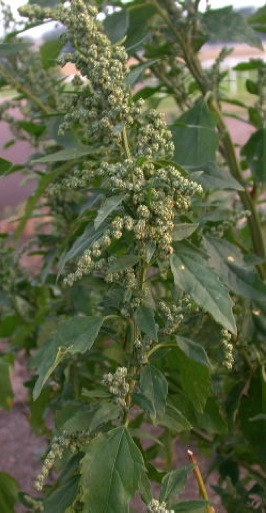Chenopodium album: Getting Goosed!
My first recollection of Chenopodium album, pigweed, came around 1960 via a neighbor named Bill Gowan.
Mr. Gowan was what you’d call a wiry man; not tall, not muscular, but strong and an excellent gardener. He, and his wife Maxine Lambert, had degrees in agriculture and were making a good effort at running a farm next door raising a few thousand chickens and seven kids.
As was the case back then neighbors helped neighbors. He was over to our place working with us on some plumbing when he saw a huge crop of pigweed where the lawn was supposed to be. (Earlier that year my father had spread hay chaff from the barn on the dirt area set aside for lawn and grew a gigantic crop of wild mustard and pigweed but no grass.)
As Mr. Gowan was leaving he stopped, chewed his pipe stem, slid back on one hip as was his habit, and remarked that the pigweed was very fine looking and would we mind if he took some home for supper? That caught my ears because I didn’t know they were edible. My father told him to take all he wanted and Mr. Gowan went over and yanked up four or five plants that were much taller than he was. He wrestled them from the hard soil and took them all home, stems and all. I can still remember the happy glee he had hauling them out and taking them away. He was a perpetualy skinny man of prodigious appetite so I’m sure he looked forward to them with his lips a-smacking. He never let them grow in his very neat garden. Pigweed ( Lambsquarters, Fat Hen ) is the fastest growing Chenopodium. There are many members of the family: Don’t eat it if it has a strong varnish-like smell. That would be one of a few used for spice or medicine. (See Epazote.) Well… I say don’t eat it if it smells like varnish but in some countries they manage to get around Epazote’s odor and use it as a green as well as flavoring and medicine.
Here in suburban Central Florida it is difficult to find enough Chenopodium album (ken-o-POE-dee-um AL-bum) to make a meal out of. Not two miles from me used to be about 20 acres of it every year but now that old frozen orange grove is a coiffured upscale, fenced housing development. I haven’t even seen a single pigweed growing outside the big brick fence. I still see a Chenopodium now and then but usually just one straggling plant at a stop sign or the like. To bad because it is a choice potherb, mild in flavor and nutritious. If you have the time the best place to find them now is in less-than-well tended orange groves.
That Chenopodium is an edible is not in doubt, leaves to processed seeds. It has been a mainstay of many for centuries. However, whether the extremely common C. album is a native to North America is something of a debate. Probably not. However C. berlandieri (bur-lan-dee-ER-ee) is native and is used the same way. It was cultivated as long as 3,500 years ago. Chenopodium means goose foot, referring to the shape of the leaves. Album (see photo on top) means white as the leaves often have a dusting of white making them unwettable. Pigweed can have up to 19,000 IU’s of vitamin A per 100g serving.
Among the known edible Chenopodiums are: bonus-henricus, californicum, capitatum, fremontii, leptophyllum, rubrum, urbicum. The next three are used as spices: C. ambrodioides, pueblense and botrys, though I think that is stretching the definition of spice. They stink. Use sparingly. Also avoid the smelly medicinal C. anthelminticum. It’s in league with the previous three only stronger.
As for the name Lambsquarters… It has nothing to do with Lambs at all. In ninth century England (some say Scotland) the calendar was divided into four quarters. The one starting August first was called Lammas Quarter. It was then folks celebrated the wheat harvest. They ate a green, leafy plant then and called it Lambsquarters.
Green Deane’s “Itemized” Plant Profile
IDENTIFICATION: Large plant, to six feet or more, often mealy early in the season, leaves very variable, diamond-shaped widest point usually well below the middle, narrowing to two straight untoothed sides making a V-shaped base, and with straightish toothed sides to the tip. Flowers ball-like clusters arranged in spikes. The minute flowers have five green sepals, five yellow stamens.
TIME OF YEAR: Young shoots in spring, leaves summer and fall, seeds fall.
ENVIRONMENT: Waste ground to fertile gardens.
METHOD OF PREPARATION: Young leaves raw, older leaves sweated or boiled, seeds after soaking overnight and rinsed well to remove saponins on surface. Chenopodium is a nitrogen holding plant and high in oxalic acid. Best avoided by those with kidney stones, gout or related issues. Seed is 49% carbohydrate, 16% protein, and 5.88% ash. Water the seeds are soaked in can be used as soap.



